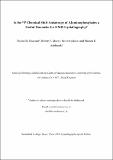Files in this item
Is the 31P chemical shift anisotropy of aluminophosphates a useful parameter for NMR crystallography?
Item metadata
| dc.contributor.author | Dawson, Daniel M. | |
| dc.contributor.author | Moran, Robert F. | |
| dc.contributor.author | Sneddon, Scott | |
| dc.contributor.author | Ashbrook, Sharon E. | |
| dc.date.accessioned | 2019-09-02T23:39:28Z | |
| dc.date.available | 2019-09-02T23:39:28Z | |
| dc.date.issued | 2019-05 | |
| dc.identifier | 255194409 | |
| dc.identifier | 044700df-7033-40cc-bb16-eac60031a6d9 | |
| dc.identifier | 85053436321 | |
| dc.identifier | 000465601100003 | |
| dc.identifier.citation | Dawson , D M , Moran , R F , Sneddon , S & Ashbrook , S E 2019 , ' Is the 31 P chemical shift anisotropy of aluminophosphates a useful parameter for NMR crystallography? ' , Magnetic Resonance in Chemistry , vol. 57 , no. 5 , pp. 176-190 . https://doi.org/10.1002/mrc.4788 | en |
| dc.identifier.issn | 0749-1581 | |
| dc.identifier.other | ORCID: /0000-0002-4538-6782/work/56638909 | |
| dc.identifier.other | ORCID: /0000-0002-8110-4535/work/59464829 | |
| dc.identifier.uri | https://hdl.handle.net/10023/18408 | |
| dc.description | The authors acknowledge the EPSRC for support through the Collaborative Computational Project on NMR Crystallography (CCP-NC), via EP/M022501/1, and for a studentship to SS. SEA would also like to thank the Royal Society and Wolfson Foundation for a merit award. This research made use of the EaStCHEM Research Computing Facility. The UK 850 MHz solid-state NMR Facility used in this research was funded by EPSRC and BBSRC (contract reference PR140003), as well as the University of Warwick including via part funding through Birmingham Science City Advanced Materials Projects 1 and 2 supported by Advantage West Midlands (AWM) and the European Regional Development Fund (ERDF). | en |
| dc.description.abstract | The 31P chemical shift anisotropy (CSA) offers a potential source of new information to help determine the structures of aluminophosphate framework materials (AlPOs). We investigate how to measure the CSAs, which are small (span of ~20-30 ppm) for AlPOs, demonstrating the need for CSA-amplification experiments (often in conjunction with 27Al and/or 1H decoupling) at high magnetic field (20.0 T) to obtain accurate values. We show that the most shielded component of the chemical shift tensor, δ33, is related to the length of the shortest P-O bond, whereas the more deshielded components, δ11 and δ22 can be related more readily to the mean P-O bond lengths and P-O-Al angles. Using the case of Mg-doped STA-2 as an example, the CSA is shown to be much larger for P(OAl)4–n(OMg)n environments, primarily owing to a much shorter P-O(Mg) bond affecting δ33, however, since the mean P-O bond lengths and P-O-T (T = Al, Mg) bond angles do not change significantly between P(OAl)4 and P(OAl)4–n(OMg)n sites, the isotropic chemical shifts for these species are similar, leading to overlapped spectral lines. When the CSA information is included, spectral assignment becomes unambiguous, therefore, while the specialist conditions required might preclude the routine measurement of 31P CSAs in AlPOs, in some cases (particularly doped materials), the experiments can still provide valuable additional information for spectral assignment. | |
| dc.format.extent | 1484255 | |
| dc.language.iso | eng | |
| dc.relation.ispartof | Magnetic Resonance in Chemistry | en |
| dc.subject | Solid-state NMR spectroscopy | en |
| dc.subject | 31P | en |
| dc.subject | Chemical shift anisotropy | en |
| dc.subject | CSA | en |
| dc.subject | Aluminophosphates | en |
| dc.subject | AlPOs | en |
| dc.subject | DFT calculations | en |
| dc.subject | QD Chemistry | en |
| dc.subject | DAS | en |
| dc.subject.lcc | QD | en |
| dc.title | Is the 31P chemical shift anisotropy of aluminophosphates a useful parameter for NMR crystallography? | en |
| dc.type | Journal article | en |
| dc.contributor.sponsor | EPSRC | en |
| dc.contributor.sponsor | EPSRC | en |
| dc.contributor.sponsor | The Royal Society | en |
| dc.contributor.institution | University of St Andrews. EaSTCHEM | en |
| dc.contributor.institution | University of St Andrews. School of Chemistry | en |
| dc.identifier.doi | https://doi.org/10.1002/mrc.4788 | |
| dc.description.status | Peer reviewed | en |
| dc.date.embargoedUntil | 2019-09-03 | |
| dc.identifier.grantnumber | EP/F018096/1 | en |
| dc.identifier.grantnumber | EP/M022501/1 | en |
| dc.identifier.grantnumber | WM150021 | en |
This item appears in the following Collection(s)
Items in the St Andrews Research Repository are protected by copyright, with all rights reserved, unless otherwise indicated.

